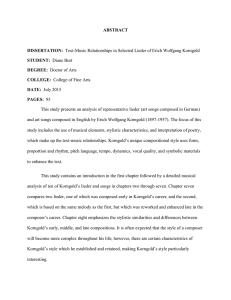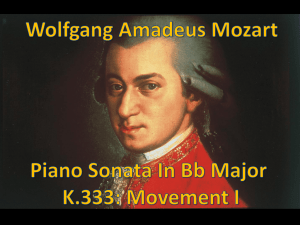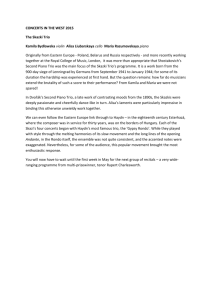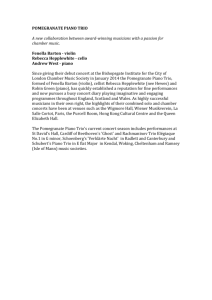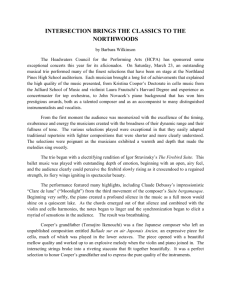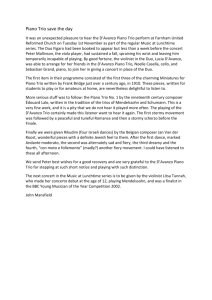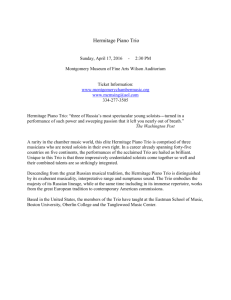the program notes. - The Chamber Music Society of Lincoln Center
advertisement
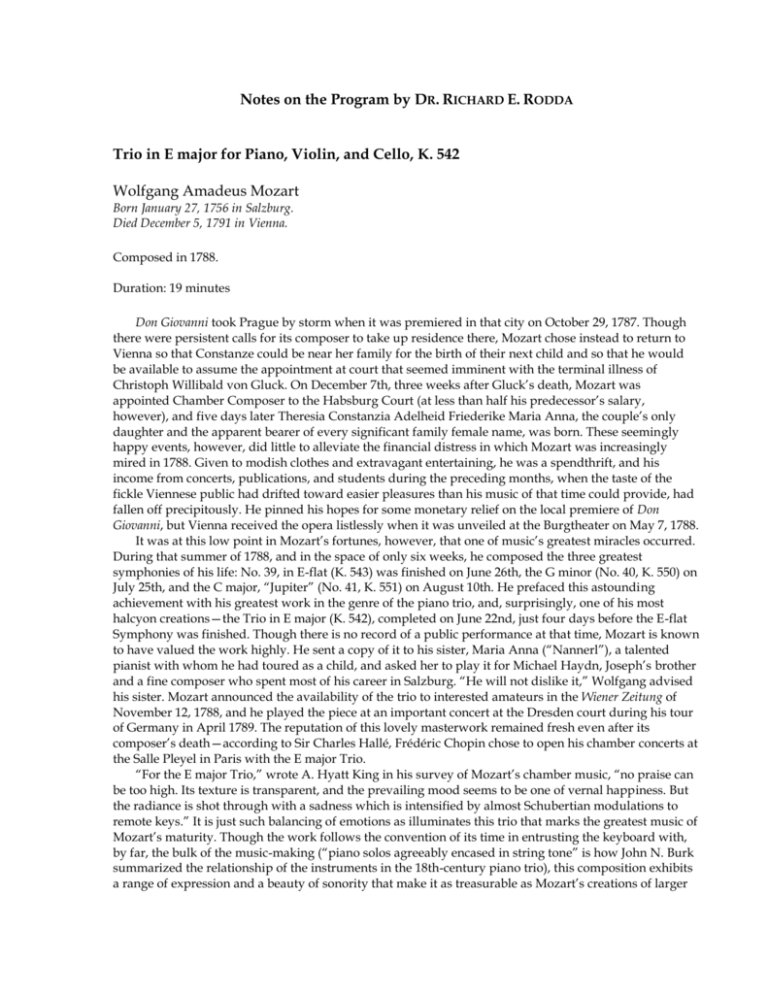
Notes on the Program by DR. RICHARD E. RODDA Trio in E major for Piano, Violin, and Cello, K. 542 Wolfgang Amadeus Mozart Born January 27, 1756 in Salzburg. Died December 5, 1791 in Vienna. Composed in 1788. Duration: 19 minutes Don Giovanni took Prague by storm when it was premiered in that city on October 29, 1787. Though there were persistent calls for its composer to take up residence there, Mozart chose instead to return to Vienna so that Constanze could be near her family for the birth of their next child and so that he would be available to assume the appointment at court that seemed imminent with the terminal illness of Christoph Willibald von Gluck. On December 7th, three weeks after Gluck’s death, Mozart was appointed Chamber Composer to the Habsburg Court (at less than half his predecessor’s salary, however), and five days later Theresia Constanzia Adelheid Friederike Maria Anna, the couple’s only daughter and the apparent bearer of every significant family female name, was born. These seemingly happy events, however, did little to alleviate the financial distress in which Mozart was increasingly mired in 1788. Given to modish clothes and extravagant entertaining, he was a spendthrift, and his income from concerts, publications, and students during the preceding months, when the taste of the fickle Viennese public had drifted toward easier pleasures than his music of that time could provide, had fallen off precipitously. He pinned his hopes for some monetary relief on the local premiere of Don Giovanni, but Vienna received the opera listlessly when it was unveiled at the Burgtheater on May 7, 1788. It was at this low point in Mozart’s fortunes, however, that one of music’s greatest miracles occurred. During that summer of 1788, and in the space of only six weeks, he composed the three greatest symphonies of his life: No. 39, in E-flat (K. 543) was finished on June 26th, the G minor (No. 40, K. 550) on July 25th, and the C major, “Jupiter” (No. 41, K. 551) on August 10th. He prefaced this astounding achievement with his greatest work in the genre of the piano trio, and, surprisingly, one of his most halcyon creations—the Trio in E major (K. 542), completed on June 22nd, just four days before the E-flat Symphony was finished. Though there is no record of a public performance at that time, Mozart is known to have valued the work highly. He sent a copy of it to his sister, Maria Anna (“Nannerl”), a talented pianist with whom he had toured as a child, and asked her to play it for Michael Haydn, Joseph’s brother and a fine composer who spent most of his career in Salzburg. “He will not dislike it,” Wolfgang advised his sister. Mozart announced the availability of the trio to interested amateurs in the Wiener Zeitung of November 12, 1788, and he played the piece at an important concert at the Dresden court during his tour of Germany in April 1789. The reputation of this lovely masterwork remained fresh even after its composer’s death—according to Sir Charles Hallé, Frédéric Chopin chose to open his chamber concerts at the Salle Pleyel in Paris with the E major Trio. “For the E major Trio,” wrote A. Hyatt King in his survey of Mozart’s chamber music, “no praise can be too high. Its texture is transparent, and the prevailing mood seems to be one of vernal happiness. But the radiance is shot through with a sadness which is intensified by almost Schubertian modulations to remote keys.” It is just such balancing of emotions as illuminates this trio that marks the greatest music of Mozart’s maturity. Though the work follows the convention of its time in entrusting the keyboard with, by far, the bulk of the music-making (“piano solos agreeably encased in string tone” is how John N. Burk summarized the relationship of the instruments in the 18th-century piano trio), this composition exhibits a range of expression and a beauty of sonority that make it as treasurable as Mozart’s creations of larger dimensions. The opening Allegro is based on two exquisite themes of melting loveliness which are invested with surprising depths of feeling as the movement’s sonata form unfolds. The elegant second movement—“poetic and pastoral, like a painting by Watteau,” according to Alfred Einstein—is a hybrid variations-sonata structure grown from a folk-like theme that presages some of the happiest melodic inspirations in The Magic Flute. Some tasteful episodes of piano and violin virtuosity are woven into the sun-bright sonata-rondo movement that closes this enchanting trio. Sonata in A major for Violin and Piano, Op. 47, “Kreutzer” Ludwig van Beethoven Born December 16, 1770 in Bonn. Died March 26, 1827 in Vienna. Composed in 1803. Premiered on May 24, 1803 in Vienna by violinist George Bridgetower and the composer as pianist. Duration: 33 minutes George Augustus Polgreen Bridgetower was born in Biala, Poland sometime between 1778 and 1780. His mother was of Polish or German extraction and his father, known as “The Abyssinian Prince,” was of Afro-Caribbean heritage from the West Indies. Bridgetower proved to be a remarkable prodigy of the violin, and he was accepted into the musical establishment of the Prince of Wales at Brighton when he was just ten. In 1803, Bridgetower was granted a leave of absence to visit his mother in Dresden, take the waters at Teplitz and Carlsbad, and play some concerts en route. His public and private performances in Dresden created a sensation, and his arrival in Vienna in early May was awaited by the local music lovers there with a heady mixture of excitement and curiosity. Beethoven met Bridgetower almost immediately and the two got along famously. Beethoven proposed both to write a new piece for Bridgetower’s debut in the city on May 24th and to accompany him at the piano, and he set to work immediately on a large sonata in A major that would properly display the skills of the two executants. The premiere was a success, and Bridgetower remained in Vienna until July, playing to considerable acclaim and spending many evenings with his new buddy, Ludwig van Beethoven. By all rights, this work, published as Beethoven’s “Kreutzer” Sonata in 1805 by Simrock, should be called the “Bridgetower” Sonata. According to an interview Bridgetower granted in 1845, such was the composer’s original intention, but he added that they had a quarrel “over a girl,” and Beethoven denied him the dedication in recompense. Instead, the score was inscribed to the well-known French violinist and composer Rodolphe Kreutzer, whom Beethoven had met in Vienna in 1798. The first movement of the “Kreutzer” Sonata is a formal curiosity, beginning with a slow introduction in the nominal key of A major as preface to a large sonata structure in the parallel minor mode. The main theme, given by the violin to begin the quicker tempo, is a dashing staccato phrase with a vaguely Turkish tint. The chorale-like subsidiary motive provides only a brief respite from the driving impetuosity of the music. There is considerable developmental dialogue between the instruments before the earlier themes are recapitulated. The Andante is a spacious set of variations on a long theme. The flamboyant, tarantella-rhythm finale provides a brilliant ending. Quintet in E major for Piano, Two Violins, Viola, and Cello, Op. 15 Erich Wolfgang Korngold Born May 29, 1897 in Brünn, Austria (now Brno, Czech Republic). Died November 29, 1957 in Hollywood, California. Composed in 1921-22. Premiered on February 16, 1923 in Hamburg by the Bandler Quartet with the composer as pianist. Duration: 31 minutes Erich Wolfgang Korngold (his middle name honored Mozart) was the younger son of Julius Korngold, one of Vienna’s most influential music critics at the turn of the 20th century. By age five, Erich was playing piano duets with his father; two years later he began composing, and at nine he produced a cantata (Gold) that convinced his father to enroll him at the Vienna Conservatory. When Mahler heard Erich play his cantata the following year, he proclaimed the boy “a genius” and arranged for him to take lessons with Alexander Zemlinsky. Korngold made remarkable progress under Zemlinsky—his Piano Sonata No. 1 was published in 1908, when he had ripened to the age of 11. The following year he wrote a ballet, Der Schneemann (The Snowman), which was staged at the Vienna Royal Opera at the command of Emperor Franz Josef. In 1911, the budding composer gave a concert of his works in Berlin, in which he also appeared as piano soloist. Korngold was an international celebrity at 13. In 1915 and 1916, Korngold wrote the first two of his five operas: Der Ring des Polykrates, a comedy, and Violanta, a tragedy. Following a two-year stint in the Austrian army playing piano for the troops during World War I, Korngold turned again to opera, producing his dramatic masterpiece, Die Tote Stadt (The Dead City), which was premiered simultaneously in Hamburg (where he served as conductor for three years after the war) and Cologne on December 4, 1920; Die Tote Stadt was the first German opera performed at the Met following World War I. After Korngold returned to Vienna in 1920, he was appointed professor of opera and composition at the Staatsakademie. In 1934, the Austrian director Max Reinhardt was conscripted by Warner Brothers in Hollywood to film a version of A Midsummer Night’s Dream. He chose to use Mendelssohn’s incidental music as background, and took Korngold along to arrange the score. Korngold, who, as a Jew, felt increasingly uneasy in Austria, accepted other offers in Hollywood, and, when the Nazi Anschluss in 1938 prevented him from returning home, he settled permanently in California. (He became a United States citizen in 1943.) For the next seven years, he devoted his talents to creating a body of film music unsurpassed by that of any other composer in the genre and won two Academy Awards (for Anthony Adverse and The Adventures of Robin Hood). His father’s death in 1945, however, caused him to re-evaluate his career, and he returned to writing concert music with concertos for violin (for Heifetz) and cello, and a large symphony. Korngold died on November 29, 1957, and his remains were interred in the Hollywood Cemetery, within a few feet of those of Douglas Fairbanks, Sr., D.W. Griffith, and Rudolf Valentino. Despite the flood of offers for conducting jobs, performances, personal appearances, and social engagements that followed the sensational premiere of Die Tote Stadt in December 1920—as well as a blossoming love affair with Luzi von Sonnenthal, a musically talented girl of whose theatrical family the elder Korngolds heartily disapproved (Erich, of course, married her, in April 1924)—the 23-year-old Korngold still found time to compose. Among his first efforts after Die Tote Stadt was the Quintet for Piano and Strings, composed in 1921-22 and dedicated to the family’s friend Gustinus Ambrosi, the Viennese sculptor who created portrait busts of such famous personalities as Strauss, Stefan Zweig, Mussolini, Clemenceau, and Strindberg. In 1912, he made a likeness of the teenage Korngold that was destroyed when the Nazis broke into the Korngolds’ home in 1938. The quintet was premiered in Hamburg on February 16, 1923 by the Bandler Quartet with the composer as pianist, introduced to Vienna in June, and heard again at the Salzburg Festival in August. The broad lyricism, rich sonority, impeccable craftsmanship, and touching expression that made Die Tote Stadt a hit are transferred to a more intimate venue in the Piano Quintet. The performance instruction for the first movement—“with animated radiant expression”—is perfectly embodied in the vaulting main theme. A gentler strain, almost a love song, provides the second subject. The development section is a fascinating thing: a finely gauged passage troubled by trills, glissandos, contrapuntal disputations, and unsettled emotions from which the movement’s essential lyricism is again wrested to lead to the recapitulation. The Adagio, with its deep sincerity of expression and its moments of soaring melodic beauty balanced by episodes of intense drama, is a virtual microcosm of Korngold’s creative personality. The movement is based on Mond, so gehst du wieder auf, the third of the Four Songs of Farewell (Op. 14), composed just before the quintet, which Korngold associated with his yet unfulfilled love for Luzi: Moon, thou risest thus again/Over somber vale of tears unwept and burning./Teach, oh teach me, pray,/To cease this steadfast yearning. The finale is strongly rhythmic, brilliantly virtuosic, and buoyantly optimistic. ©2014 Dr. Richard E. Rodda

